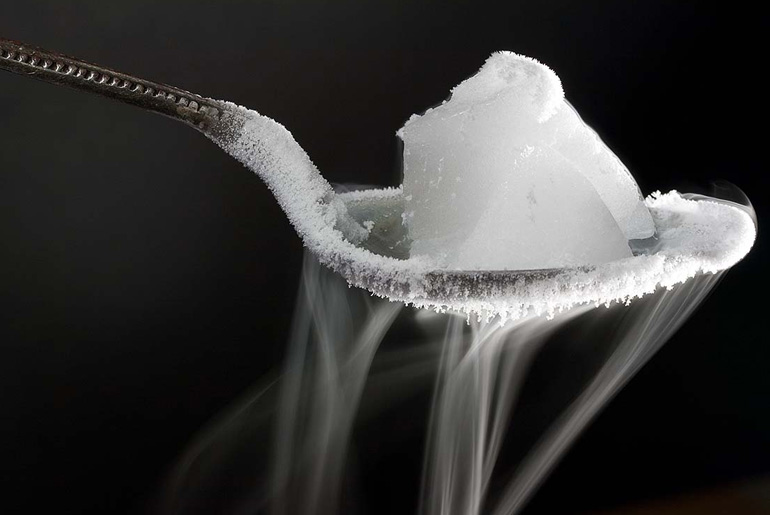Dry ice is the solid state of carbon dioxide (CO2) and is commonly utilized for food preservation and creating fog effects in theatres. With an extremely low temperature of about -78 degrees Celsius, significantly colder than the freezing point of water, direct exposure, whether through touching, inhalation, or consumption, poses severe health risks. In a recent incident in a Gurugram cafe, five individuals fell ill after being served dry ice instead of a regular mouth freshener. Following consumption, they reportedly began spitting out blood and experienced severe discomfort, highlighting the importance of proper handling and awareness of the potential hazards associated with dry ice.
According to the Food Safety and Standards Authority of India (FSSAI), dry ice serves as a cooling agent for various food products, including ice cream and frozen desserts. It is employed to maintain the required cold or frozen temperatures for food items without the use of mechanical cooling.
In the event of mistakenly swallowing dry ice, a health emergency may arise, resulting in various issues such as frostbite, breathlessness, burns to the mouth, and vomiting. Immediate action is crucial in such situations. The affected individual should be given a cooling agent or antacid promptly to help alleviate symptoms.
Dry ice:
Dry ice is the solid state of carbon dioxide (CO2) at an extremely low temperature of -78.5°C. This unique substance finds versatile applications, primarily serving as a potent refrigerant due to its frigid temperature. Beyond its role in cooling, dry ice is widely employed in creating theatrical smoke or fog effects, enhancing visual experiences in entertainment. Additionally, it plays a crucial role in shipping and preservation, especially for perishable items, as its cold temperature helps maintain a frozen environment. The distinctive properties of dry ice make it a valuable and practical tool in various industries, where its extreme coldness and ability to sublimate directly from a solid to a gas contribute to its widespread utility.
Dangers of dry ice:
Dry ice, as the solid form of carbon dioxide, presents significant hazards if mishandled or ingested. The extreme coldness of dry ice can cause frostbite and tissue damage upon contact, leading to necrosis and potentially severe injuries. Ingestion of dry ice can result in a range of adverse effects, including breathlessness, vomiting, burns to the mouth and gastrointestinal tract, bloating, abdominal pain, and even asphyxiation if carbon dioxide gas replaces oxygen in the bloodstream. Recent incidents, such as the one at Laforestta Cafe in Gurugram, highlight the dangers of mistakenly ingesting substances like dry ice. Therefore, it’s imperative for restaurants and individuals to prioritize safety by carefully vetting ingredients and adhering to strict safety protocols to prevent accidents and protect patrons from harm.
Additionally, liquid nitrogen, another substance often used for culinary effects, poses similar risks if ingested. Despite its theatrical appeal, liquid nitrogen can cause severe internal damage, including frostbite and tissue damage, leading to vomiting, bleeding, and other serious health complications. Both dry ice and liquid nitrogen should never be consumed and require careful handling to avoid accidents and potential harm. Awareness of the dangers associated with these substances is essential for ensuring the safety of individuals and preventing harmful incidents in various settings.
Preventing dangers of dry ice consumption:
1. Seek Medical Attention Immediately:
- Call emergency services or go to the nearest emergency room.
- Inform medical professionals about the ingestion of dry ice for prompt and appropriate treatment.
2. Avoid Forcing Vomiting:
- Do not induce vomiting, as the rapid release of carbon dioxide gas during vomiting can cause additional harm.
3. Provide Antacid or Cooling Agent:
- While waiting for medical help, if advised by a healthcare professional, you may offer the person small sips of water or milk to help dilute the dry ice and provide a cooling effect.
- Do not force the person to drink if they are having difficulty swallowing or breathing.
4. Stabilize Vital Signs:
- Monitor the person’s vital signs, including heart rate, breathing, and blood pressure.
- If the person shows signs of distress or loss of consciousness, basic life support measures may be necessary until professional medical help arrives.
Remember, these steps are general guidelines, and the primary action should be seeking immediate medical attention. Ingesting dry ice is a serious emergency that requires specialized medical intervention due to the potential for severe respiratory and cardiovascular complications.
Disclaimer:
The information contained in this article is for educational and informational purposes only and is not intended as a health advice. We would ask you to consult a qualified professional or medical expert to gain additional knowledge before you choose to consume any product or perform any exercise.






